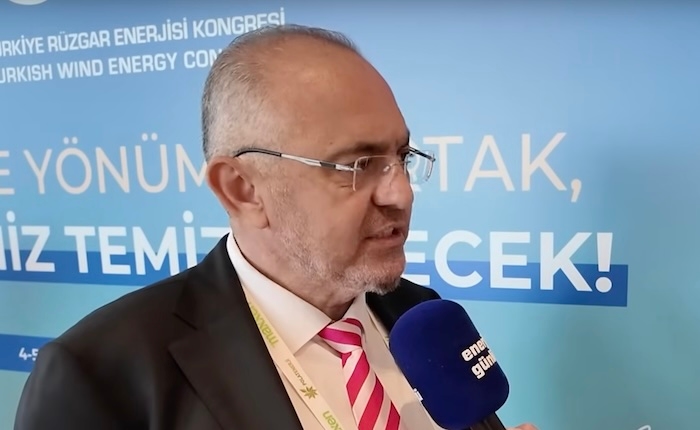Kalaycı: The wind industry should be able to see the future for 5 years

MEHMET KARA - EXCLUSIVE INTERVIEW
Türkiye, which is striving to reduce its dependence on foreign energy resources such as natural gas, oil, and coal, continues its efforts to create a domestic industry and ecosystem for energy equipment. However, achieving lasting results in this area is proving challenging.
Macroeconomic difficulties, both internationally and domestically, are negatively impacting efforts in this area. Indeed, some recent negative news has emerged from the wind energy equipment industry, particularly concentrated in the Bursa-Izmir region and the surrounding areas. While domestic turbine blade manufacturing facilities have closed, it has become uncertain whether investors who won wind power plant license tenders requiring domestic equipment will be able to meet these requirements.
We spoke to Alper Kalaycı, President of ENSIA, the Energy Industrialists' and Businessmen's Association, who has been closely monitoring developments in this area. Kalaycı shared with Enerji Günlüğü his assessment of the challenges facing the domestic wind energy equipment sector and how they can be overcome.
There is troubling news coming from the wind industry, especially from Izmir. What is going on?
The first industrial wind energy production in Türkiye began in Izmir. Izmir has a 24-year history in the wind industry. Since the first step was taken in Izmir, other companies subsequently chose the city to manufacture both towers and blades. A significant cluster has developed here over the past 25 years. However, especially in the last few years, due to insufficient exchange rate fluctuations, high interest rates, and high inflation, costs have begun to rise significantly. Therefore, producing blades for export is currently not feasible.
But there is a serious demand inside...
There's demand domestically, but it's not actually that serious. It's not serious in the following sense. So, considering our current YEKA projects, we have a domestic blade requirement of 1,000 MW per year. 1,000 MW per year is normally the production a single factory can produce with two molds. So, we're not talking about production for two, three, or four factories. With annual volumes of 3,000-4,000 MW, you can feed three or four factories.
Could you be a little more concrete about the extent of the current financial distress?
Let's put it this way: in recent years, we were talking about a labor cost in wing production in Türkiye that was below that of all European countries. In fact, we were talking about figures 20% or 30% lower than in some countries. Currently, we're talking about costs that exceed those of major and large European Union countries like Portugal and Poland. We're almost reaching the costs of Italy. Therefore, producing in Portugal and supplying the European market from there, or producing in Poland and supplying the Northern European market, offers a significant advantage in terms of labor.
Does it all come down to just labor costs?
So, there's no other solution. Labor costs are crucial for wing production. From rental costs to raw material costs, there haven't been any significant changes. Raw material prices skyrocketed during the pandemic, but they've since rebounded. I'm talking about raw material prices, but I'm also talking about all the expenses involved in maintaining a factory. This includes energy costs, service costs, and food costs. Food costs used to be insignificant; you could ignore them. Now, these are becoming increasingly significant.
So what do you suggest?
The current pressure on exchange rates is particularly impacting this. Inflation and exchange rate increases have not been synchronized over the past few years. In the past, one year would go a little overboard, and the next year they would find balance. The gap there has widened significantly. Many exporters are also raising the issue that exchange rates are not where they should be.
Where should it be?
If you're asking where it should be, technically it's about twice that. Considering all the cost increases in the country, inflation rates, and all the other figures, the exchange rate today, for example, should be around 80 lira to the dollar.
As ENSIA, are you taking any action on these issues?
We're raising the issue that there are challenges in the sector. There are also solutions, and we're working to bring them to the forefront. To summarize, YEKA projects, which require local production, need to be implemented at a much higher volume. Most importantly, the YEKA timetable needs to be clear. In other words, both investors and production companies need to know when and how many megawatts of capacity will be allocated for the next five years in order to be able to plan.
It is said that YEKA tenders will be held every year, and this year's tenders have already been announced...
Great, I hope we can do it, but will it happen next year? How many megawatts (MW) will it be? Will it happen in 2027? How many MW will it be, and when? Knowing these things is crucial. Manufacturers should know so they can take precautions accordingly. Only then, if necessary, will we have the opportunity to say, "Be patient during the bad times, wait for the good times." Our sector needs to be able to foresee the future regarding domestic production for the next five years. This is crucial.
Mehmet KARA - Energy Diary
enerjigunlugu





